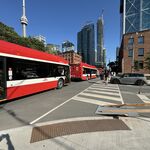Just FYI I have reached out to Via Rail to get more details about the recent interviews done with its CEO about getting HFR going. Expect a story on the site in the next few days - probably an opinion piece. I moved back to Toronto from London UK in 2014 so perhaps you can imagine my views on Via's current service!
I distinctly remember in college taking the Via home and a british dude quite vocally complaining on how slow the train was haha.
What if I told you that there are quite a few HSR (!) services in Europe, which operate at lower average speeds than VIA Rail's Corridor trains or Amtrak's Acela Express, despite a significantly higher maximum speed?

There have been so many scenarios. My lowest cost scenario:
- Coproduction on CP from De Beaujeu to Beare
- New heavy duty freight track Coteau to De Beaujeu ( only 6 miles)
- CTC on CP Winchester Sub, not necessarily retaining all double track
- Eight new siding extensions on CP Smiths Falls to Cherrywood, three mile siding length
- Connecting track CN to CP at Beare, and near Belleville
- Complete a third track on Kingston Sub Belleville to Kingston, 40 mph freight speed, not signalled, dedicated to CN roadswitchers, passing track every 20 miles
- Possibly short third track for CN Oshawa to Bowmanville, in Cobourg and Port Hope
VIA takes posession of CN line Liverpool to Coteau. CN retains trackage rights for local shipments only east of Kingston. CN serves Kingston and Bath via local track from Belleville. CN serves customers east of Kingston by roadswitchers based in Brockville, accessed via trackage rights from Smiths Falls
At this point, VIA has eliminated freight interference, which is sufficient to achieve a 4 hour schedule to Montreal and less to Ottawa, on greater frequency, with existing track and signals. From that point, you can incrementally upgrade with gradual growth in ridership.
[..]
[...]
Co-production could be in place by late 2019. One year of design and two summers to build the junctions at Beare and De Beaujeau, and lengthen the sidings. CTC on the Winchester is doable in this time frame.
Once you get the bulk of the freight off the CN Kingston line, you get an immediate timetable improvement thru both faster schedules and more frequent trains, and you can work at your own pace from there. CN can run its road switchers at night to serve on line customers - the freight tonnage would not be enough to degrade tracks. [...]
What legal precedents and government reports or statements from CN, CP or Transport Canada make you so confident that CN and CP could be enticed to commit to "co-production" or that the government has any intentions to force such practices?
[..]
- ViA slowly upgrades Toronto- Kingston to 120 mph service on the two former CN tracks, which become passenger-only.
- Later, the Gananoque connection is constructed as an incremental project.
- Later, Smiths Falls Sub is double tracked.
- Later, this line is electrified
- Paul
[...]
Once you have a third track for CN, you upgrade the two existing tracks and install PTC to give you 125 mph capability. The line needs to be grade separated so this might take a while as crossings are eliminated. CN won't need a third track end to end - there are only customers in a handful of places.
If the Kingston-Smiths Falls short cut is part of the plan (and it should be) the Kingston-Brockville-Coteau leg might only need to be 100 mph or so. That's enough for direct Montreal-Toronto service to be improved. CN can stay on the existing rails. I would plan for 125 mph Oshawa-Kingston-Smiths Falls - Ottawa - Coteau only.
- Paul
You seem to either not be aware of the level crossing regulations in Canada which
force grade separations for speeds above 110 mph or underestimate the cost premium of having to grade separate every single level crossing.
2019 is not possible if the Peterboro line is the route. Huge amount of environmental and design work required, and then lots of construction. Let's not pretend this is "fixing" an old rail line. It would be a total new construction job. And some of the land has been sold and might require expropriation. There are buildings on the old ROW in places. I don't believe this is actually the preferred route. [..]
[...]
As far as I know, the entire former ROW section of the Havelock subdividison has been sold to the counties it traversed, which now host the Trans Canada Trail on it. As long as the trial is preserved and just moved by few meters, I don't believe this to be that problematic. Furthermore, reusing a former ROW ensures that there are no big earthworks to be done to re-accommodate rail services (unless where realignments are deemed necessary)...
[...]
I predict that First Nations consultation and negotiation will be part of the deal. There is a real opportunity to do something positive in this regard, on whatever route. VIA contracts out track maintenance already, and this could be an opportunity for a partnership - set up a First Nations run contracting firm to do the civil construction work and then the track maintenance. The First Nations along the Lakeshore are sophisticated and could manage this. Could lead to skills development and job opportunities. I would predict that Cabinet would insist on leveraging this project along these lines.
[...]
[...]
I raised the First Nations issue primarily in the context of whether 2019 is possible. Whether there is a partnership proposed or not, it will require time and effort to hold consultations and reach understandings. VIA can't pull a Metrolinx and just plunk a new line down without this step. Treaty status in the GTA is much clearer than in parts of Eastern Ontario. As noted, some may feel that VIA is not welcome on their land at all.
- Paul
At least in the
map you provided in a later post, I cannot see how the Havelock subdivision conflicts with any First Nation areas.
For once can we not get the watered down version of transportation infrastructure? I see the advantages of having a designated passenger rail line, but can it please be high-speed? Sorry, but I'm not inspired by a new train that only shaves 45 minutes off the trip to Montreal. This is the most populous and economically important part of the country. Let's do it right.
Ever wondered how Canada has avoided building HSR while studying it for 30 years by now? I can't help myself to at least partly blame compulsion of "thinking big", "don't compromise" and "let's do it right". Shouldn't we passenger rail enthusiasts finally start to acknowledge that almost all HSR nations' main motivation for building HSR were severe capacity issues in their conventional passenger (not: freight!) rail networks (while travel time savings only played a secondary role - at least for the initial HSR network) and that all these countries started at roughly a third of the distance we are obsessing about with Quebec-Windsor, which would instantly catapult Canada from zero to the
second-most dense HSR network in the world (if it was only ever built)?
That would be a very late Canadian. It takes the Richmond Hill corridor into Union Station.
I can't deny that delayed arrivals of the Canadian at an extent of the 5 hours suggested here (or even more) have happened in the past, but it seems like it arrived Toronto less than 1 hour late yesterday, so maybe that
Metrolinx spokeswoman was already up a lot earlier yesterday morning than you assume...






